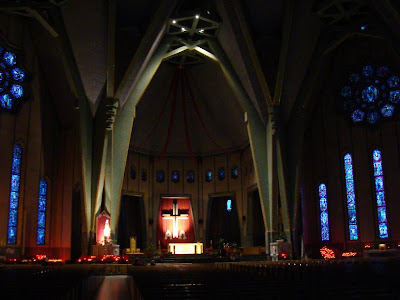After several weeks of intense exam prep and paper-writing, I'm officially done with the spring semester. The end of the semester typically leaves me bewildered and spent, as frenetic days of nonstop reading and writing very abrubtly give way to days when I seemingly have nothing to do. The feeling of having nothing to do is purely illusory - I actually have a lot of loose ends to tie together before I leave New York for the summer - but it's nice to be able to work at a more relaxed pace than I'm able to during the semester. In fact, I'm looking forward to rereading some of the books I was assigned over the past academic year, this time at a more reflective pace and without having to worry about writing papers based on their contents.
My summer will involve a fair amount of travel to new and familiar destinations. Through the kindness of my provincial, I'll be making my annual eight-day retreat in Jerusalem along with a few other scholastics from my province. This won't be my first visit to the Holy Land - I made a trip there in March 2000, while I was a student at Georgetown - but it will be my first as a Jesuit. On the way to and from Jerusalem, I'll be spending a few days in the Netherlands with family and friends. After a brief stop back in New York, I'll be off to Chile for a month to work on my Spanish.
To round out this post, I should say something about my recent extracurriculars. I've often told people in person (and perhaps also written on this blog) that what I enjoy most about living in New York is being able to take advantage of the cultural opportunities available here in the city. Before I came to Fordham, I'd often read about different events in the Arts section of the
New York Times and think, "I wish I could do go to that." Now I'm at least theoretically able to say "I
could go to that," subject to the limitations imposed by a Jesuit scholastic's budget and a graduate student's schedule.
Though I've been fairly busy over the past month writing papers and studying for exams, I have found the time to attend musical peformances at the Metropolitan Opera and at Carnegie Hall. In late April I had a chance to check out
the Met's production of Philip Glass's Satyagraha, an opera about M. K. Gandhi's years in South Africa. Coming from an unconventional composer,
Satyagraha is a fairly unusual opera - the libretto consists entirely of passages from the
Bhagavad Gita, and the work eschews linear narrative in favor of what might best be described as an attempt to get inside Gandhi's mind to try to understand how he came to embrace the path of nonviolent resistance. Though I didn't quite know what to expect, I found
Satyagraha very moving - I liked the arresting visuals (which included the use of puppets -
something the Met is doing a lot of these days) and I appreciated the music as well, though I started to find Glass's trademark repetition a bit grating towards the end.
Last Friday I went to Carnegie Hall to hear
Bernard Haitink conduct the
Chicago Symphony Orchestra in
a program of works by Joseph Haydn and Dmitri Shostakovich. This was my first time seeing Haitink and the CSO live, though I've been a fan of both for a while. I'm also a fan of Shostakovich, so it was a great pleasure for me to hear Haitink (one of the greatest living intepreters of Shostakovich's work) conduct his
Symphony No. 4. I'm less familiar with the work of Haydn, and Friday's performance was the first time I'd ever heard his
Symphony No. 101, aptly nicknamed "The Clock" on account of the 'tick-tock' rhythm of its second movement. My brother Jesuit and fellow concertgoer Julian Climaco and I parted company in our estimation of Shostakovich - Julian found the 4th too dissonant for his liking - but we both liked "The Clock." On the whole, Haitink and the CSO both lived up to their respective reputations, and I hope to hear both again. In the meantime, I'm grateful for the opportunities that I've had here in New York, and I'm looking forward to the summer. AMDG.










